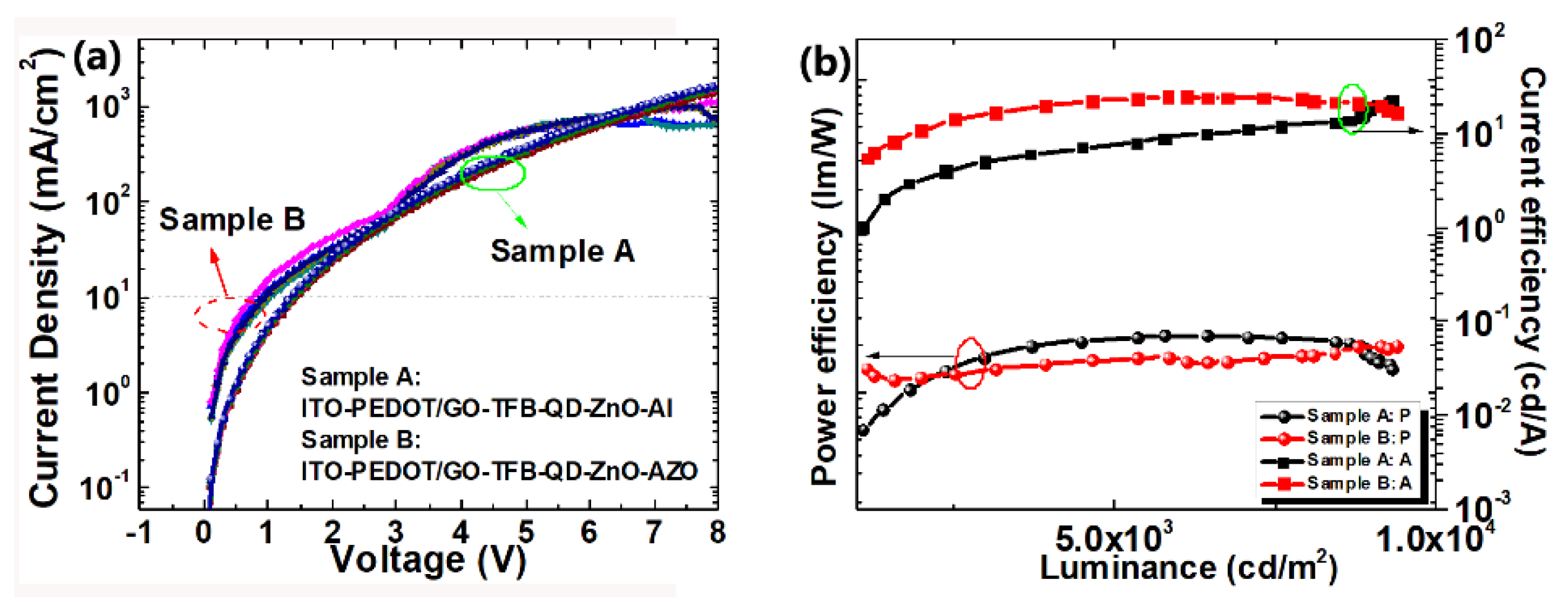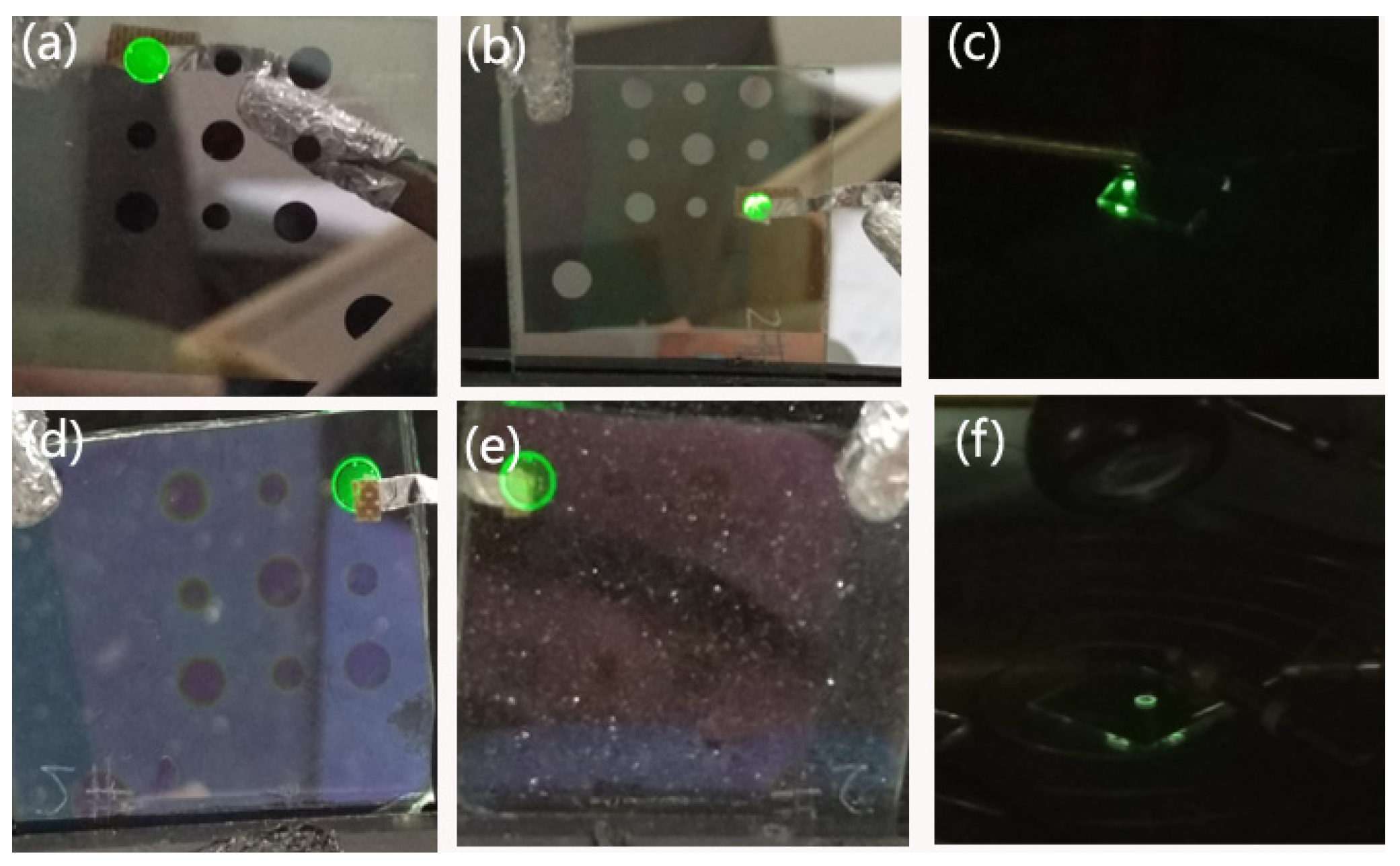Dual-Facets Emissive Quantum-Dot Light-Emitting Diode Based on AZO Electrode
Abstract
:1. Introduction
2. Materials and Methods
3. Results
4. Conclusions
Supplementary Materials
Author Contributions
Funding
Institutional Review Board Statement
Informed Consent Statement
Data Availability Statement
Conflicts of Interest
References
- Kim, T.H.; Cho, K.S.; Lee, E.K.; Lee, S.J.; Chae, J.; Kim, J.W.; Kim, D.H.; Kwon, J.Y.; Amaratunga, G.; Lee, S.Y.; et al. Full-colour quantum dot displays fabricated by transfer printing. Nat. Photonics 2011, 5, 176–182. [Google Scholar] [CrossRef]
- Pan, J.Y.; Zhao, Z.H.; Fang, F.; Wang, L.X.; Wang, G.Z.; Liu, C.J.; Chen, J.; Xie, J.; Sun, J.Y.; Wang, K.; et al. Multiple Cations Enhanced Defect Passivation of Blue Perovskite Quantum Dots Enabling Efficient Light-Emitting Diodes. Adv. Opt. Mater. 2020, 8, 2001494. [Google Scholar] [CrossRef]
- Wang, L.X.; Pan, J.Y.; Qian, J.P.; Liu, C.J.; Zhang, W.; Akram, J.; Lei, W.; Chen, J. Performance Enhancement of All-Inorganic Quantum Dot Light-Emitting Diodes via Surface Modification of Nickel Oxide Nanoparticles Hole Transport Layer. ACS Appl. Electron. Mater. 2019, 1, 2096–2101. [Google Scholar] [CrossRef]
- Wang, L.X.; Pan, J.Y.; Liu, C.J.; Zhao, Z.H.; Fang, F.; Wang, Y.; Wang, G.Z.; Lei, W.; Chen, J.; Zhao, D.W. Tailoring Nanostructures of Quantum Dots toward Efficient and Stable All-Solution Processed Quantum Dot Light-Emitting Diodes. ACS Appl. Mater. Interfaces 2021, 13, 17861–17868. [Google Scholar] [CrossRef]
- Han, Y.J.; Kang, K.T.; Ju, B.K.; Cho, K.H. Effect of Time-Dependent Characteristics of ZnO Nanoparticles Electron Transport Layer Improved by Intense-Pulsed Light Post-Treatment on Hole-Electron Injection Balance of Quantum-Dot Light-Emitting Diodes. Materials 2020, 13, 5041. [Google Scholar] [CrossRef]
- Jang, E.; Jun, S.; Jang, H.; Lim, J.; Kim, B.; Kim, Y. White-Light-Emitting Diodes with Quantum Dot Color Converters for Display Backlights. Adv. Mater. 2010, 22, 3076–3080. [Google Scholar] [CrossRef] [PubMed]
- Achermann, M.; Petruska, M.A.; Koleske, D.D.; Crawford, M.H.; Klimov, V.I. Nanocrystal-Based Light-Emitting Diodes Utilizing High-Efficiency Nonradiative Energy Transfer for Color Conversion. Nano Lett. 2006, 6, 1396–1400. [Google Scholar] [CrossRef]
- Yang, X.; Hernandez-Martinez, P.L.; Dang, C.; Mutlugun, E.; Zhang, K.; Demir, H.V.; Sun, X.W. Electroluminescence Efficiency Enhancement in Quantum Dot Light-Emitting Diodes by Embedding a Silver Nanoisland Layer. Adv. Opt. Mater. 2015, 3, 1439–1445. [Google Scholar] [CrossRef]
- Qian, L.; Zheng, Y.; Xue, J.; Holloway, P.H. Stable and efficient quantum-dot light-emitting diodes based on solution-processed multilayer structures. Nat. Photonics 2011, 5, 543–548. [Google Scholar] [CrossRef]
- Wang, J.W.; Luo, F.F.; Ouyang, G.X.; Shi, Y. Magnetic, optical and electrical properties of ITO thin films implanted by cobalt ions. Nucl. Instrum. Methods Phys. Res. Sect. B Beam Interact. Mater. At. 2019, 450, 234–238. [Google Scholar] [CrossRef]
- Bhosle, V.; Prater, J.T.; Yang, F.; Burk, D.; Forrest, S.R.; Narayan, J. Gallium-doped zinc oxide films as transparent electrodes for organic solar cell applications. J. Appl. Phys. 2007, 102, 023501. [Google Scholar] [CrossRef]
- Owen, J.; Son, M.S.; Yoo, K.H.; Ahn, B.D.; Lee, S.Y. Organic photovoltaic devices with Ga-doped ZnO electrode. Appl. Phys. Lett. 2007, 90, 033512. [Google Scholar] [CrossRef]
- Park, H.K.; Kang, J.W.; Na, S.I.; Kim, D.Y.; Kim, H.K. Characteristics of indium-free GZO/Ag/GZO and AZO/Ag/AZO multilayer electrode grown by dual target DC sputtering at room temperature for low-cost organic photovoltaics. Sol. Energy Mat. Sol. Cells 2009, 93, 1994–2002. [Google Scholar] [CrossRef]
- Yao, L.; Fang, X.; Gu, W.; Zhai, W.; Wan, Y.; Xie, X.; Xu, W.; Pi, X.; Ran, G.; Qin, G. Fully Transparent Quantum Dot Light-Emitting Diode with a Laminated Top Graphene Anode. ACS Appl. Mater. Interfaces 2017, 9, 24005–24010. [Google Scholar] [CrossRef] [PubMed]
- Seo, J.-T.; Han, J.; Lim, T.; Lee, K.-H.; Hwang, J.; Yang, H.; Ju, S. Fully Transparent Quantum Dot Light-Emitting Diode Integrated with Graphene Anode and Cathode. ACS Nano 2014, 8, 12476–12482. [Google Scholar] [CrossRef]
- Yan, L.; Zhang, Y.; Zhang, X.; Zhao, J.; Wang, Y.; Zhang, T.; Jiang, Y.; Gao, W.; Yin, J.; Zhao, J.; et al. Single layer graphene electrodes for quantum dot-light emitting diodes. Nanotechnology 2015, 26, 135201. [Google Scholar] [CrossRef] [PubMed]
- Tang, Z.; Lin, J.; Wang, L.; Luo, J.; Zhao, J.; Li, H.; Wang, Y.; Liu, X. Inverted structural quantum dot light-emitting diodes based on Al-doped ZnO electrode. Nanotechnology 2017, 28, 365201. [Google Scholar] [CrossRef]
- Bae, W.K.; Char, K.; Hur, H.; Lee, S. Single-step synthesis of quantum dots with chemical composition gradients. Chem. Mater. 2008, 20, 531–539. [Google Scholar] [CrossRef]
- Chen, J.; Pan, J.; Huang, Q.; Xu, F.; Zhang, Z.; Lei, W.; Nathan, A. Graphene oxide/PEDOT:PSS as injection layer for quantum dot light emitting diode. Phys. Status Solidi 2015, 212, 2856–2861. [Google Scholar] [CrossRef]
- Chen, J.; Zhao, D.W.; Li, C.; Xu, F.; Lei, W.; Sun, L.T.; Nathan, A.; Sun, X.W. All Solution-processed Stable White Quantum Dot Light-emitting Diodes with Hybrid ZnO@TiO2 as Blue Emitters. Sci. Rep. 2014, 4, 4085. [Google Scholar] [CrossRef] [PubMed] [Green Version]
- Panasiuk, Y.V.; Raevskaya, O.E.; Stroyuk, O.L.; Kuchmiy, S.Y.; Dzhagan, V.M.; Hietschold, M.; Zahn, D.R.T. Colloidal ZnO Nanocrystals in Dimethylsulfoxide: A New Synthesis, Optical, Photo- and Electroluminescent Properties. Nanotechnology 2014, 25, 075601. [Google Scholar] [CrossRef] [PubMed]




| Turn-On Voltage (V) | Maximum Brightness (cd/m2) | Power Efficiency (lm/W) | Current Efficiency (cd/A) | |
|---|---|---|---|---|
| Sample A | 2.7 | 9300 | 12.5 | 23.0 |
| Sample B | 2.3 | 9450 | 15.7 | 25.5 |
Publisher’s Note: MDPI stays neutral with regard to jurisdictional claims in published maps and institutional affiliations. |
© 2022 by the authors. Licensee MDPI, Basel, Switzerland. This article is an open access article distributed under the terms and conditions of the Creative Commons Attribution (CC BY) license (https://creativecommons.org/licenses/by/4.0/).
Share and Cite
Chen, J.; Huang, Q.; Lei, W. Dual-Facets Emissive Quantum-Dot Light-Emitting Diode Based on AZO Electrode. Materials 2022, 15, 740. https://doi.org/10.3390/ma15030740
Chen J, Huang Q, Lei W. Dual-Facets Emissive Quantum-Dot Light-Emitting Diode Based on AZO Electrode. Materials. 2022; 15(3):740. https://doi.org/10.3390/ma15030740
Chicago/Turabian StyleChen, Jing, Qianqian Huang, and Wei Lei. 2022. "Dual-Facets Emissive Quantum-Dot Light-Emitting Diode Based on AZO Electrode" Materials 15, no. 3: 740. https://doi.org/10.3390/ma15030740





